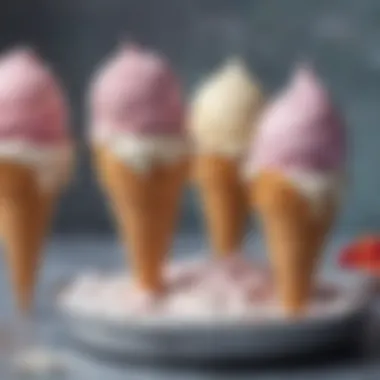Unveiling the Intricate Art of Crafting Ice Cream


Science Fun Facts
Ice cream, a delectable frozen dessert enjoyed by many, holds within it a blend of various key ingredients. Beyond the classic flavors of vanilla and chocolate, have you ever pondered the science behind crafting unique and tantalizing tastes such as rocky road or salted caramel? The freezing process of ice cream actually plays a crucial role in determining its texture and mouthfeel. By scrutinizing the balance between fat, sugar, and air in the mixture, ice cream artisans can achieve the perfect creamy consistency, enticing our taste buds with each scoop.
Discover the Wonders of Science
As we delve deeper into the realm of ice cream making, we encounter a myriad of scientific concepts at play. From the principles of freezing points and emulsions to the significance of overrun in creating that tantalizing fluffiness, the process of making ice cream unfolds as a symphony of intricate chemistry and physics. By exploring these scientific underpinnings, we not only appreciate the artistry of ice cream making but also gain a newfound admiration for the delicate balance of ingredients that transform liquid cream into a frozen masterpiece.
Science Experiment Showcase
Embarking on the journey of making ice cream from scratch can be likened to a thrilling scientific experiment. With just a few simple ingredients like cream, sugar, and flavorings, coupled with the transformative power of cold temperatures, we can witness the magical process of liquid turning into a creamy solid. By following precise measurements, stirring techniques, and patience during the freezing stage, young aspiring chefs can conduct their own flavorful experiments in the realm of frozen desserts. Remember, safety is paramount when working with cold temperatures, so be sure to enlist adult supervision and handle ingredients with care to enjoy the sweet rewards of your culinary exploration.
The Indroduction of Ice Cream-Making This article dwells into the captivating realm of making ice cream, delving deep into every intricate detail that forms the foundation of this frozen delight. Ice cream-making is not just a culinary process but an art that requires precision, passion 🍦, and a deep understanding of the elements at play. Exploring this topic is not only a journey through history and culture but a sensory experience that showcases the fusion of science and creativity seamlessly. From the selection of premium ingredients to the final presentation, each step contributes to the magic of crafting delectable ice cream
History of Ice Cream Ice cream has a rich and storied past that dates back centuries, evolving from simple chilled desserts to the decadent treat we know today. As far back as the 2nd century B.C., ancient civilizations indulged in frozen concoctions resembling ice cream. Over time, this dessert gained popularity among the elite in Europe, eventually becoming a mass-produced commodity enjoyed by people worldwide. Understanding the history of ice cream provides insight into its cultural significance and the innovations that have shaped it over generations.## lution of Ice Cream The evolution of ice cream mirrors societal changes, technological advancements, and culinary innovations throughout history. From the early days of hand-churning and natural ice harvesting to modern industrial production methods, the journey of ice cream is a testament to human ingenuity. The invention of the ice cream churn in the 19th century revolutionized the dessert industry, paving the way for diverse flavors, textures, and styles of ice cream we relish today. Exploring the evolution of ice cream unveils a fascinating tale of adaptation, experimentation, and sheer indulgence.## Si icance of Ice Cream in Culinary Culture Ice cream holds a special place in culinary culture, transcending borders and generations as a universal symbol of joy and indulgence. Whether enjoyed as a simple scoop on a hot summer day or as a lavish dessert at a celebratory feast, ice cream elicits nostalgic memories and fosters social connections. Its versatility in flavor combinations and presentation styles allows chefs 🧁 and home cooks alike to express their creativity and whimsy. Recognizing the significance of ice cream in culinary culture underscores its enduring appeal and the role it plays in enriching our gastronomic experiences.
Ingredients Selection
When embarking on the journey of making ice cream, one cannot underestimate the critical role of ingredients selection. Every component plays a pivotal part in determining the final texture, flavor, and overall quality of the frozen dessert. Careful consideration should be given to each element, from dairy products to sweeteners and flavorings, to ensure a harmonious blend that delights the palate.
Quality of Dairy Products
Delving into the realm of dairy products, a cornerstone of ice cream making, the selection process requires a discerning eye. First and foremost, choosing the right milk sets the foundation for the entire concoction. Opting for high-quality milk with a rich fat content contributes to a creamy mouthfeel and luxurious texture. The nuances in milk compositions, such as whole milk versus skim milk, impact the final product's richness and density.
Moving on to selecting cream, another essential dairy component, the decision rests on achieving the perfect balance between fat content and consistency. Cream enhances the smoothness and creaminess of the ice cream, elevating it from ordinary to extraordinary. The selection of cream can range from heavy cream to double cream, each lending its unique characteristics to the dessert.
Equally crucial is picking the best eggs, as they act as emulsifiers and provide structure to the ice cream. Fresh, high-quality eggs ensure a velvety consistency and help in preventing ice crystals from forming. The yolks impart a luscious richness while also contributing to the custard-like base of the ice cream.
Sweeteners and Flavorings
Shifting focus to sweeteners and flavorings, they add depth and complexity to the ice cream profile. The role of sugar goes beyond sweetness; it aids in lowering the freezing point of the mixture, resulting in a softer texture. Selecting the right type and quantity of sugar is vital in achieving the desired balance of sweetness without overpowering other flavors.
Enhancing flavors with vanilla and other ingredients introduces a myriad of creative possibilities. Vanilla, with its aromatic qualities, can act as a standalone flavor or as a base for various combinations. Other flavorings, such as fruits, nuts, or extracts, offer a spectrum of tastes to experiment with, from classic to experimental.
In essence, the nuances of ingredients selection underscore the artistry of making ice cream, where precision and quality converge to create a frozen masterpiece.
Science Behind Freezing


In the complex realm of ice cream making, the Science Behind Freezing stands as a pivotal element, dictating the final texture and consistency of this beloved frozen dessert. Understanding the intricacies of how freezing techniques affect the formation of ice crystals is paramount to achieving that perfect scoop. Embracing the Science Behind Freezing delves deep into the molecular interactions that take place when liquid transforms into a solid state, elucidating the impact of temperature manipulation on crystal growth and structure. As ice cream enthusiasts embark on their journey to craft the ultimate frozen treat, comprehending the nuances of this scientific process elevates their culinary prowess and ensures gastronomic delight.
Ice Crystal Formation
At the core of ice cream's tantalizing texture lies the fascinating process of Ice Crystal Formation. One of the most critical components of frozen dessert preparation, the formation of ice crystals directly influences the mouthfeel and consistency of the final product. Examining the delicate balance between ice crystal size and distribution unveils the delicate artistry behind creating a luxuriously smooth ice cream.
Impact of Freezing Temperatures
Unveiling the Impact of Freezing Temperatures sheds light on how different chilling conditions influence the crystal formation within ice cream. The intricacy of selecting the ideal temperature regime encompasses a delicate dance between promoting optimal crystal growth for a creamy texture and preventing crystal aggregation for a velvety mouthfeel. Experimenting with varying freezing temperatures allows artisans to refine their craft and tailor their frozen creations to suit diverse palates.
Controlling Crystal Size
Mastering the technique of Controlling Crystal Size is a cornerstone of ice cream perfection. By regulating the growth and distribution of ice crystals, artisans can fine-tune the consistency and mouthfeel of their frozen creations. Striking the delicate balance between crystal size and quantity ensures a decadent and indulgent scoop with every bite. Skillfully controlling crystal size empowers ice cream makers to craft a sensory experience that captivates the palate and leaves a lasting impression.
Emulsification Process
Venturing deeper into the realm of ice cream alchemy, the Emulsification Process emerges as a key player in achieving a velvety smooth texture and rich mouthfeel. By harmonizing fats and liquids through emulsifiers, ice cream artisans navigate the intricate process of blending contrasting elements into a harmonious whole.
Stabilizing Fat and Water Mixture
The critical role of Stabilizing Fat and Water Mixture revolves around creating a cohesive blend that prevents ingredient separation and ensures a luxuriously creamy consistency. By integrating stabilizers, artisans fortify the emulsion, resulting in a sumptuously smooth and indulgent ice cream experience.
Role of Emulsifiers
Highlighting the essential Role of Emulsifiers unveils their transformative impact on ice cream texture. Emulsifiers act as molecular architects, binding fats and liquids together to create a uniform consistency and prevent crystallization. Embracing the role of emulsifiers empowers ice cream aficionados to craft velvety-smooth frozen confections that delight the senses and elevate the culinary experience.
Churning Techniques
In the realm of ice cream craftsmanship, Churning Techniques play a fundamental role in infusing air and creating a luxuriously smooth texture that defines exceptional frozen desserts.
Incorporating Air into the Mixture
The art of Incorporating Air into the Mixture introduces lightness and fluffiness to ice cream, ensuring a lusciously airy finish that delights the palate. By deftly incorporating air bubbles during churning, artisans elevate the texture of their frozen creations, leading to a delectably smooth and creamy mouthfeel that epitomizes artisanal craftsmanship.
Creating Smooth Texture
Mastering the technique of Creating Smooth Texture is essential for crafting ice cream that melts seductively on the tongue. By blending and agitating the mixture to achieve optimal homogenization, artisans achieve a silken consistency that is synonymous with premium frozen desserts. The quest for a flawlessly smooth texture drives ice cream enthusiasts to experiment with churning methods and techniques, honing their skills to perfection and delivering a sensory experience that surpasses expectations.


Freezing Methods
Contemplating on the essential aspect of freezing methods is paramount in comprehending the intricate process of crafting impeccable ice cream. The technique utilized in freezing directly influences the texture, consistency, and overall quality of the end product. By intricately exploring various freezing methods, one can gain a deeper insight into the meticulous art of ice cream making. Understanding the nuances of freezing methods enables ice cream enthusiasts to tailor their approach according to personal preferences and desired outcomes.
Traditional Ice Cream Makers
Delving into the realm of traditional ice cream makers unveils a rich tapestry of historical practices and time-honored techniques that have shaped the evolution of this delectable treat. Within this classic framework, several intriguing methods stand out, each with its distinct charm and contribution to the craft.
Manual Churning
Embarking on the methodical journey of manual churning introduces a sense of nostalgia and authenticity to the ice cream-making process. This hands-on approach involves the manual rotation of a churn, gradually transforming the liquid mixture into a velvety and indulgent delight. The rhythmic motion of churning intricately incorporates air into the mixture, resulting in a lusciously smooth texture that captivates the palate. While manual churning demands patience and physical effort, the exquisite results it yields make it a cherished choice for connoisseurs seeking a traditional ice cream experience.
Use of Rock Salt and Ice
The utilization of rock salt and ice in the freezing process symbolizes a time-honored technique that dates back centuries. By harnessing the combined power of salt and ice, this method creates a frigid environment essential for freezing the ice cream base. The rock salt lowers the freezing point of the ice, enabling it to achieve temperatures necessary for solidifying the mixture. While requiring careful monitoring and maintenance, the use of rock salt and ice imparts a unique element of craftsmanship to the ice cream-making ritual.
Hand-Cranked Machines
Exploring the realm of hand-cranked machines transports aficionados back to an era where craftsmanship and dedication prevailed in the realm of frozen desserts. These intricate machines, operated by hand, embody a sense of artisanal flair and meticulous attention to detail. The laborious process of hand cranking tirelessly churns the mixture to perfection, ensuring optimal incorporation of air for a luxuriously creamy outcome. Although time-consuming, the charm and authenticity of hand-cranked machines continue to attract enthusiasts seeking a hands-on approach to creating exceptional frozen delicacies.
Modern Freezing Techniques
Venturing into the realm of modern freezing techniques unveils a cutting-edge approach to ice cream making, where innovation and technology converge to redefine this frozen confection. Within this innovative landscape, contemporary methods offer a glimpse into the future of ice cream production, showcasing efficiency and precision like never before.
Electric Ice Cream Makers
Embracing the convenience and efficiency of electric ice cream makers revolutionizes the process of homemade ice cream production. These user-friendly appliances automate the churning process, sparing enthusiasts the physical exertion traditionally associated with manual methods. The rapid rotation of electric components ensures consistent and smooth results, enabling individuals to effortlessly craft batch after batch of decadent ice cream. While streamlining the production process, electric ice cream makers uphold the standards of quality and taste that discerning palates demand.
Liquid Nitrogen Freezing
Embarking on the avant-garde journey of liquid nitrogen freezing exemplifies the pinnacle of technological advancement in ice cream production. This cutting-edge technique harnesses the ultra-low temperatures of liquid nitrogen to flash-freeze the dessert mixture instantaneously, resulting in extraordinarily creamy and smooth ice cream. The rapid freezing process prevents ice crystal formation, preserving the delicate structure of the treat and yielding a sublime sensory experience. While requiring specialized equipment and expertise, liquid nitrogen freezing offers a tantalizing glimpse into the future of ice cream innovation, where science and indulgence harmoniously converge.
Flavor Infusion and Varieties
When it comes to the world of ice cream, flavor infusion and varieties play a crucial role. The art of infusing flavors into ice cream opens up a realm of creative possibilities for crafting unique and delightful frozen treats. Incorporating a variety of flavors and mix-ins not only enhances the taste but also adds an element of surprise and indulgence to each scoop. In this article, we will delve into the significance of flavor infusion and explore different varieties that cater to diverse palates and preferences, elevating the experience of making and enjoying ice cream to new heights.
Incorporating Mix-Ins


Folding in Chunks and Swirls
The technique of folding in chunks and swirls is a fundamental aspect of crafting delectable ice cream with textural interest and flavor bursts. When incorporating mix-ins like chocolate chunks or fruit swirls, the process of folding ensures even distribution throughout the ice cream base, creating a harmonious blend of flavors and textures. The key characteristic of this method lies in its ability to maintain the integrity of the mix-ins, preventing them from becoming too homogenized within the ice cream. This meticulous process of incorporation adds layers of complexity and depth to the final product, making it a popular choice among ice cream enthusiasts who crave variety and excitement in each bite.
Creating Unique Combinations
Creating unique combinations of flavors and ingredients is a creative endeavor that sets artisanal ice cream apart from mass-produced varieties. By blending unexpected elements like spices with fruits or herbs with chocolate, ice cream makers can offer taste experiences that delight the palate and challenge traditional flavor norms. The unique feature of crafting these combinations lies in the innovation and experimentation involved, pushing the boundaries of conventional ice cream flavors to create avant-garde delicacies that surprise and impress. While the process of creating unique combinations requires careful consideration and balance, the rewards in terms of flavor complexity and customer satisfaction are immense.
Popular Ice Cream Flavors
Classic Vanilla and Chocolate
Classic flavors like vanilla and chocolate hold a special place in the hearts of ice cream aficionados worldwide. Their timeless appeal and versatility make them a staple in any ice cream menu, catering to both traditionalists and adventurous taste buds alike. The key characteristic of these flavors lies in their ability to serve as a blank canvas for creative toppings and mix-ins, allowing for endless customization and reinvention. While some may perceive them as safe choices, the universal popularity and nostalgic charm of classic vanilla and chocolate make them essential pillars in the world of ice cream making.
Exotic Flavors from Around the World
Exploring exotic flavors from around the world adds a touch of global flair to the ice cream experience, inviting consumers to savor unfamiliar tastes and aromas that transport them to far-off lands. Whether it's the vibrancy of tropical fruits, the richness of spices, or the subtlety of floral notes, exotic flavors bring a sense of adventure and discovery to the scoop. The key characteristic of these flavors lies in their ability to awaken the senses and provoke curiosity, enticing ice cream enthusiasts to broaden their flavor horizons and embrace novel gastronomic delights. While exotic flavors may not appeal to all palates, their ability to evoke wanderlust and cultural appreciation makes them a valuable addition to any ice cream repertoire.
Serving and Presentation
Serving and presentation are integral aspects of ice cream enjoyment. When it comes to ice cream, how it is served and presented can greatly enhance the overall experience. Proper serving techniques ensure that the ice cream reaches its ideal consistency, offering a smooth and creamy texture. Presentation, on the other hand, adds a visual appeal that entices the senses and builds anticipation. The way ice cream is served and presented can elevate a simple dessert into a luxurious indulgence. Considering serving and presentation in this article emphasizes the importance of attention to detail and the desire to create a sensory delight for anyone enjoying the frozen treat.
Ideal Scooping Techniques
Ideal scooping techniques play a crucial role in the overall ice cream experience. 'Tips for Perfect Scoops' focuses on achieving the ideal ball or quenelle shape, ensuring each serving looks visually appealing. This technique not only enhances the presentation but also contributes to portion control and consistency in serving size. The key characteristic of 'Tips for Perfect Scoops' lies in its ability to create uniform, elegant portions that are visually pleasing and easy to enjoy. The unique feature of this technique is its versatility; it can be applied to various ice cream textures, yielding consistent results each time.
'Creating Artistic Shapes' introduces a creative element to ice cream serving. By using tools like spatulas or specialty scoopers, ice cream can be molded into intricate shapes that add a decorative touch to any dish. The key characteristic of 'Creating Artistic Shapes' is the ability to elevate the visual appeal of the dessert, making it more visually engaging and inviting. This technique is popular for special occasions or gourmet presentations where aesthetics play a crucial role in the overall dining experience. While it requires a bit more skill and practice, the artistry of creating artistic shapes can turn a simple scoop of ice cream into a sophisticated dessert.
Garnishes and Toppings
Garnishes and toppings are the finishing touches that can transform a basic scoop of ice cream into a gourmet masterpiece. 'Fresh Fruits and Nuts' provide a contrast in textures and flavors, adding vibrancy and freshness to the dessert. The key characteristic of incorporating fresh fruits and nuts is the burst of natural sweetness and crunch they bring, enhancing the overall sensory experience. This choice is popular for those seeking a healthier or more vibrant dessert option. The unique feature of fresh fruits and nuts lies in their ability to add a colorful and refreshing element to the dish, making it visually appealing and nutritionally balanced.
'Decadent Sauces' offer a rich and indulgent addition to ice cream. These sauces come in various flavors like chocolate, caramel, or fruit coulis, adding depth and complexity to the dessert. The key characteristic of decadent sauces is their ability to provide a contrasting texture and flavor profile to the creamy ice cream, creating a harmonious balance of sweet and savory notes. This choice is popular among those looking for a truly indulgent treat or a flavorful twist to their dessert. The unique feature of decadent sauces is their versatility in pairing with different ice cream flavors, offering endless combinations to satisfy various taste preferences.
Conclusion
In the grand tapestry of ice cream making, the conclusion serves as the final brushstroke that completes the masterpiece. It is not merely the endpoint but a culmination of precision, patience, and passion. The significance of the conclusion lies in its ability to bring together all the elements that have been meticulously crafted throughout the entire process. It is the moment where science meets art in a harmonious blend of flavors and textures. A well-executed conclusion ensures that every scoop of ice cream is not just a dessert but an experience.
Crafting the Perfect Scoop
Crafting the perfect scoop of ice cream is an art that requires finesse and attention to detail. It involves using the right tools, like a sturdy ice cream scoop, and the perfect scooping technique to ensure smooth, round scoops that tempt the eyes as much as they tantalize the taste buds. The key to a perfect scoop lies in the angle and pressure applied while scooping, ensuring that each serving is uniform in shape and size. Whether it's a classic round scoop or an elegant quenelle, mastering the art of scooping elevates the ice cream experience to new heights.
Art and Science of Ice Cream Making
The art and science of ice cream making is a delicate balance between creativity and chemistry. It is an intricate dance of ingredients and temperatures, where precision is paramount. The artistry comes in creating unique flavor combinations and visually appealing designs, while the science delves into the precise measurements and processes that ensure a creamy, smooth texture. Understanding the molecular structure of ice cream allows for innovation and experimentation, pushing the boundaries of traditional flavors and textures. In the realm of frozen desserts, mastering the art and science of ice cream making is the ultimate key to unlocking a world of culinary delights.







